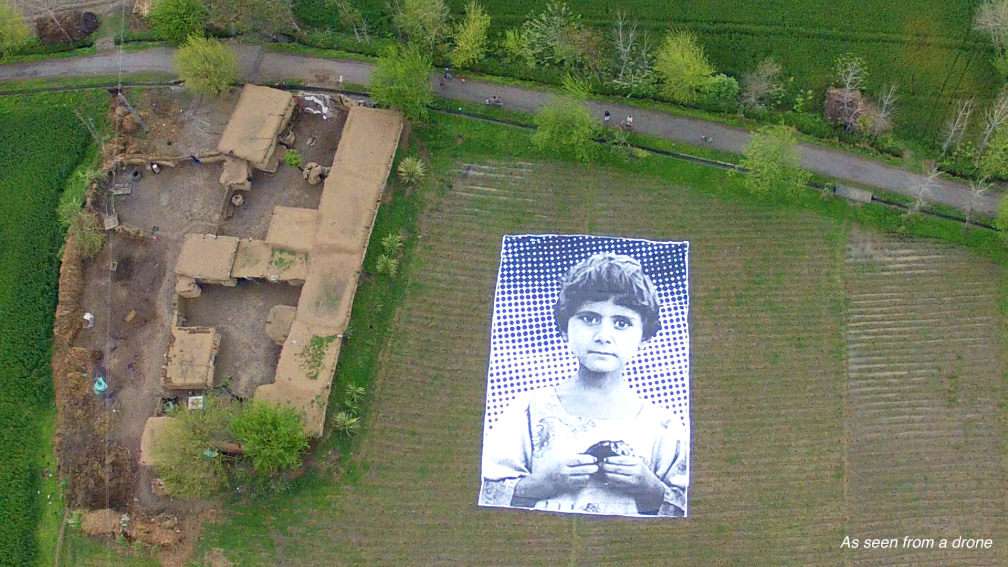Photography as a Shield: #NotABugSplat
Ever since the invention of the still camera nearly two centuries ago, the art of photography has been in a never-ending state of change and adaptation. Through every kind of cultural and technological upheaval, creative photographers have always found new ways to inform, delight, and shock the public.

Today, in the heavily-bombed Khyber Pakhtunkhwa region of Pakistan, photography is taking on a new role: defending an entire village from the possibility of an American drone strike. A group of artists, working with Reprieve/Foundation for Fundamental Rights, has made a single portrait of a child that's so massive, its every detail can be seen by predator drones hovering over the region.
The project, called #NotABugSplat, takes its name from the dehumanizing view of Pakistani landscape, as seen by drone pilots. The oversized symbol of human innocence both warns against future strikes and serves as memorial to the nearly 200 children who've been killed in strikes since 2004.
The installation also stands in contrast to more traditional forms of war photography. Although the content, purpose, and intended audience of #NotABugSplat are worlds apart from the photographs featured in daily news coverage of the region, the effect is just as unsettling.
On August 2nd, 2013, Reason TV took a close look at the work of Michael Kamber and Louie Palu, two prominent photojournalists who've chronicled the past decade of war in Iraq and Afghanistan. Like #NotABugSplat, the images of Kamber and Palu put human faces on otherwise remote and heavily censored conflicts.
Original text follows:
"We were supposed to go into Iraq, hold elections, turn over the keys, and get out," says Michael Kamber, a photojournalist and editor of the book Photojournalists on War: The Untold Stories from Iraq. "That's not how it works, and we need to think about that next time we get involved in a military adventure."
It is almost impossible to read Kamber's new book without reflecting on how many of its photographs were taken by people who were either killed, severely injured, or taken captive during the conflict. Kamber, who photographed the war over a ten year period, counts himself among the survivors. His book is a testament not only to eight years of brutal warfare, but to the 39 photographers whose work is represented in its pages.
ReasonTV sat down with Kamber at WAR/PHOTOGRAPHY, an exhibit at the Corcoran Gallery of Art, to hear the stories behind the unforgettable photographs in his book. It's an in-depth account of the Iraq War from photojournalists who witnessed key events at close range.
Many of the the book's 160 images have been widely distributed, their impact indelibly marked in the American mind. Other images, which are just as powerful, have rarely been seen. "Photojournalists on War" also includes compelling eyewitness accounts of battles, the disintegration of soldiers' marriages, and the lasting effects of post-traumatic stress disorder.
While Kamber's book chronicles the work of photojournalists who were mostly backed by major publications, images of war are increasingly made by enterprising individuals. In 2006, photojournalist Louie Palu quit his job and traveled to Afghanistan at his own risk and on his own dime. He had never covered a war before. Working without the support—or the constraints—of an editor meant that he was able to photograph with plenty of of artistic freedom. His images are stunning, and it's no surprise that his series of portraits and panoramic black-and-white shots reveal an Afghanistan that looks very different from most press photography.
Palu is also producing "The Durrani Kings" a documentary about his experiences photographing Kandahar province, the birthplace of the Taliban.
Both Palu and Kamber remain skeptical of the wars they witnessed. Broken promises and official censorship have led to a public that remains poorly informed about war's devastating effects on ordinary civilians.
It's often said that the truth is always the first casualty of war. The images of Kamber and Palu are attempts to correct the record.
The Corcoran exhibit continues until September 29.
Produced, shot, and edited by Todd Krainin.
Runs about 9 minutes.
